Lipid Nanoparticles Market Size
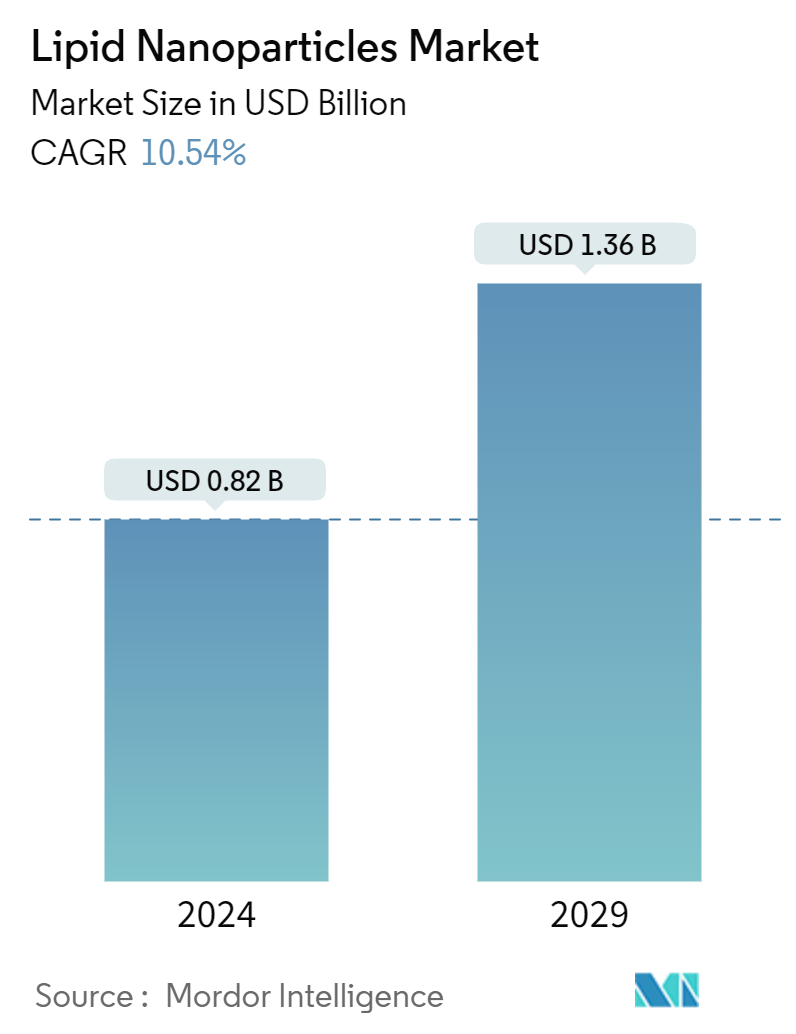
| Study Period | 2019 - 2029 |
| Market Size (2024) | USD 0.82 Billion |
| Market Size (2029) | USD 1.36 Billion |
| CAGR (2024 - 2029) | 10.54 % |
| Fastest Growing Market | Asia Pacific |
| Largest Market | North America |
| Market Concentration | Medium |
Major Players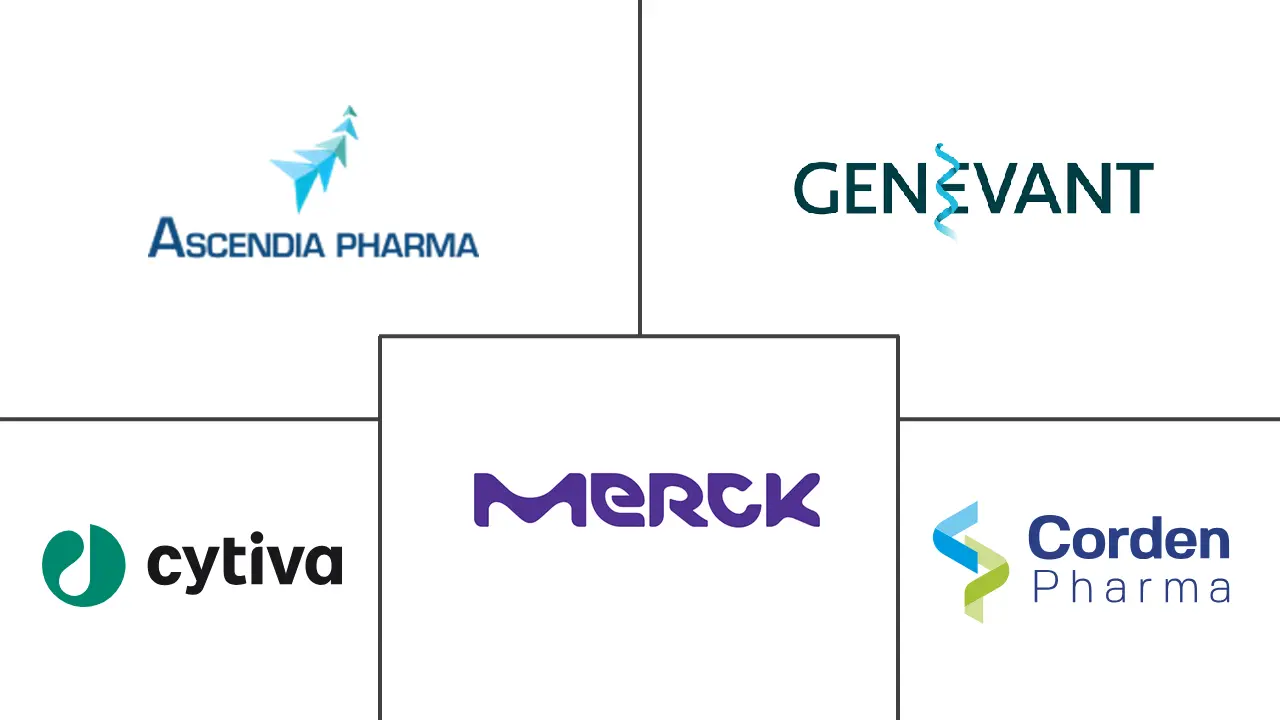
*Disclaimer: Major Players sorted in no particular order |
Lipid Nanoparticles Market Analysis
The Lipid Nanoparticles Market size is estimated at USD 0.82 billion in 2024, and is expected to reach USD 1.36 billion by 2029, growing at a CAGR of 10.54% during the forecast period (2024-2029).
Lipid nanoparticles are spherical vesicles composed of lipids. These nanoparticles offer several benefits, such as safeguarding drugs, boosting their solubility and efficacy, enabling targeted drug delivery, regulating drug release, and altering drug biodistribution. These nanoparticles can be modified based on the specific drug properties and therapeutic requirements, making potential carriers for various applications in oncology, neurological disorders, dermatology, infectious diseases, and other therapeutic areas.
The growing burden of chronic diseases and increasing investment by market players to introduce novel therapies to address this rising demand for effective therapeutic measures are significant factors influencing market growth. For instance, according to the International Agency for Research on Cancer’s 2022 report published in April 2024, there were an estimated 20 million new cancer cases reported in 2022 globally, and this disease burden is projected to increase by 77% to reach over 35 million new cancer cases in 2050 globally. In addition, cancer treatment is the most extensive application of lipid nanoparticles (LNPs) in drug delivery. These nanoparticles improve treatment outcomes through targeted drug delivery, which is anticipated to surge its demand for treating various chronic diseases, thereby driving market growth.
Furthermore, increasing government initiatives to promote innovation in healthcare and the growing focus of market players to provide technologically advanced platforms for developing novel therapies are fueling market growth. For instance, the National Institutes of Health (NIH) invests USD 200 million yearly in nanotechnology research. Lipid nanoparticles with complex structures are designed to overcome biological barriers specific to individual patients or disease status as demanded by personalized medicine. For instance, in June 2023, Hopewell Therapeutic raised USD 25 million in financing to advance the development of next-generation lipid nanoparticles for targeted delivery of genomic medicines. Hence, the growing application of nanotechnology and increasing investment by market players to incorporate this technology in developing novel therapies are projected to drive market growth over the next five years.
However, the high cost associated with formulation development, limited loading capacity, and stringent regulatory compliance may restrain the market’s growth.
Lipid Nanoparticles Market Trends
Therapeutics Segment is Expected to Witness Significant Growth During the Forecast Period
- Lipid nanoparticles (LNPs) are emerging across the pharmaceutical industry as promising vehicles to deliver a variety of therapeutics. These nanoparticles encapsulate and deliver therapeutics to specific locations within the body and release their contents at a desired time. The therapeutic application of lipid nanoparticles in drug delivery, medical imaging, cosmetics, and others is projected to grow in the upcoming years. For instance, according to a study published by the Pharmaceuticals Journal in July 2023, lipid-based nanosystems significantly improved siRNA delivery to tumor cells during breast cancer therapy. Such studies highlight that using lipid nanoparticles for targeted drug delivery enhances treatment outcomes and will likely drive its demand in the coming years.
- In addition, the number of clinical trials devoted to nanoparticles for drug delivery is increasing rapidly due to the continuous development of nanotechnology and advancements in biotechnology and medicine. For instance, per a study published by the International Journal of Molecular Sciences in January 2023, lipid-based nanoparticle drugs accounted for 21% of the US Food and Drug Administration (FDA) approved nanoparticle drugs. Hence, the increasing regulatory approvals for treating a wide range of chronic diseases are expected to contribute to the segment’s growth during the forecast period.
- The recent breakthrough in using lipid nanoparticles for mRNA vaccine delivery for COVID-19 has influenced the interest of several pharmaceutical companies worldwide. For instance, in January 2022, Pfizer Inc. entered an agreement with Acuitas Therapeutics to use the lipid nanoparticle formulation technology of Acuitas for developing mRNA vaccines and therapeutics. Moreover, market players are increasingly focusing on influencing the design and optimization of lipid nanoparticles by incorporating artificial intelligence and machine learning. Such strategic initiatives offer growth opportunities to expand lipid nanoparticle applications in various therapeutic areas, subsequently driving market growth.
- Hence, the therapeutic segment is expected to grow in the coming years due to the treatment benefits lipid nanoparticles offer in drug delivery over conventional methods.
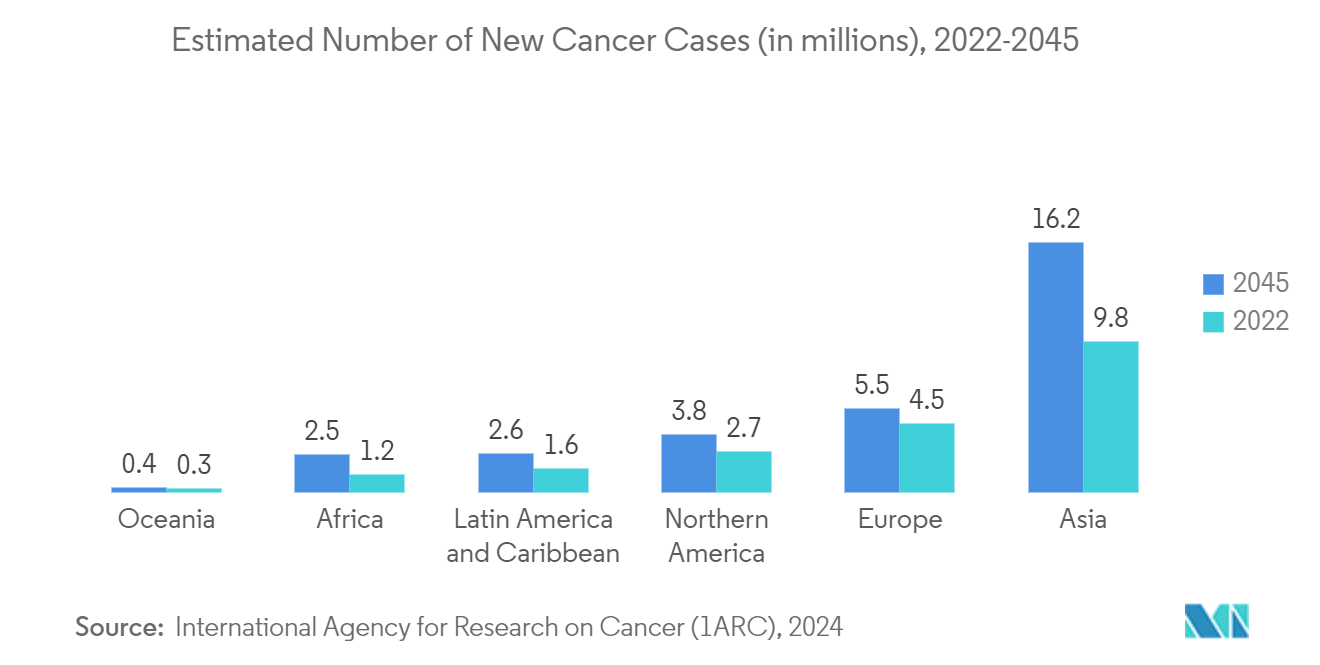
North America is Expected to Dominate the Lipid Nanoparticles Market
- North America is expected to dominate the market owing to factors such as developed healthcare infrastructure, growing investment in research and development activities, increasing prevalence of chronic diseases, continuous technological advancement in drug delivery, new product launches, and established players in the region. For instance, according to the National Association of Chronic Disease Directors data published in April 2022, around 60% of the adult American population had at least one chronic disease, among which cancer, diabetes, and cardiovascular disease ranked highest in the United States.
- As per the Canadian Cancer Statistics 2023, about two in five Canadians are expected to develop cancer in their lifetime. Such instances surge the demand for precision medicine to advance the development of lipid nanoparticles for targeted delivery and reduce the burden of diseases, thus influencing market growth in the region. Furthermore, the market is driven by increased government initiatives to support research and development of next-generation medicine. For instance, in April 2023, McGill University received USD 165 million from the government of Canada to support research on next-generation medicines. Hence, these initiatives are expected to fuel the demand for novel therapies to reduce chronic disease burden, subsequently driving the demand for lipid nanoparticles during the forecast period.
- Market players are focusing on strengthening their portfolios by making strategic alliances to expand their geographical presence and growth opportunities in the untapped market, thereby influencing market growth in the region. For instance, in August 2023, Serina Therapeutics Inc., a US-based clinical-stage biotechnology company, signed a merger agreement with AgeX Therapeutics Inc. to advance Serina's lipid nanoparticles and antibody-drug conjugates, which are under clinical study for the treatment of Parkinson's disease and other neurological diseases. Such strategic initiatives by market players to introduce advanced therapeutic measures are expected to contribute to market growth.
- Therefore, the North American region is anticipated to witness growth in the coming years due to the growing focus on personalized medicine and increasing investments by market players in nanotechnology.
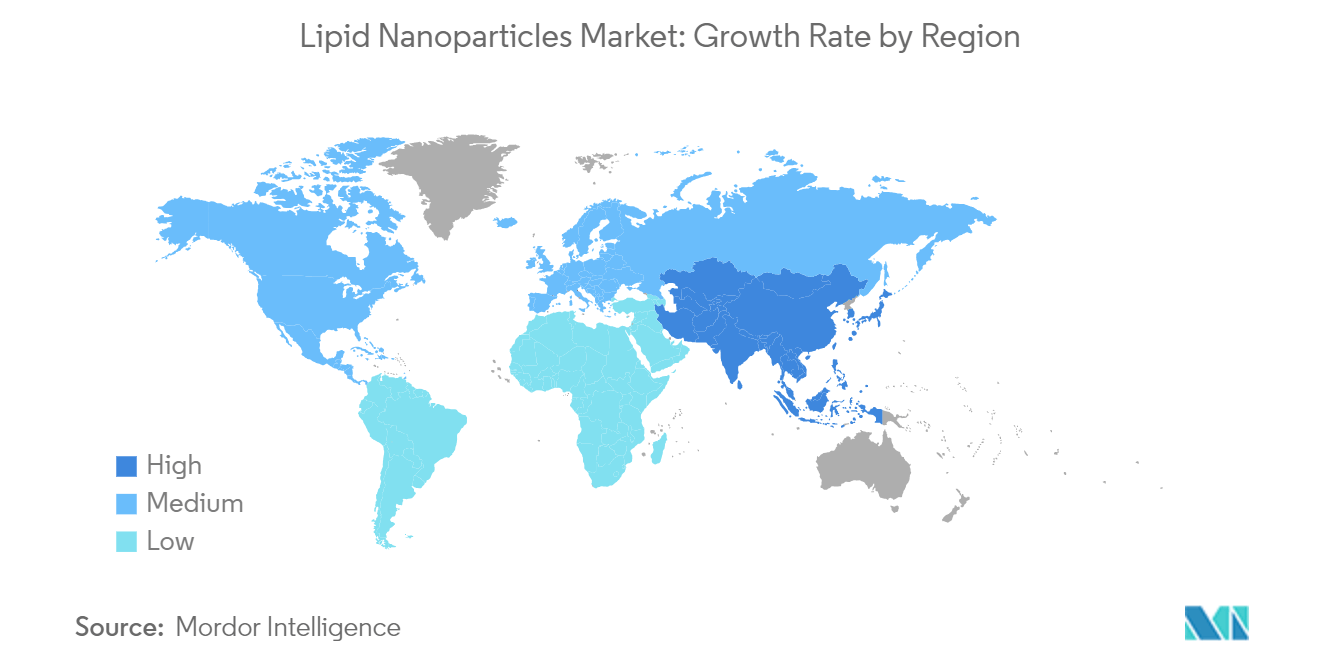
Lipid Nanoparticles Industry Overview
The lipid nanoparticles market is semi-consolidated in nature due to the presence of some key players operating globally as well as regionally. The competitive landscape includes an analysis of a few international and local companies that hold considerable market share and are well known. They include Merck KGaA, Croda International PLC, Cytiva, BIOVECTRA, Acuitas Therapeutics, CordenPharma, Genevant Sciences Corporation, Arcturus Therapeutics Inc., Ascendia Pharmaceuticals, and CD Bioparticles.
Lipid Nanoparticles Market Leaders
-
Merck KGaA
-
Arcturus Therapeutics, Inc.
-
Ascendia Pharmaceuticals
-
Acuitas Therapeutics
-
Croda International Plc.
*Disclaimer: Major Players sorted in no particular order
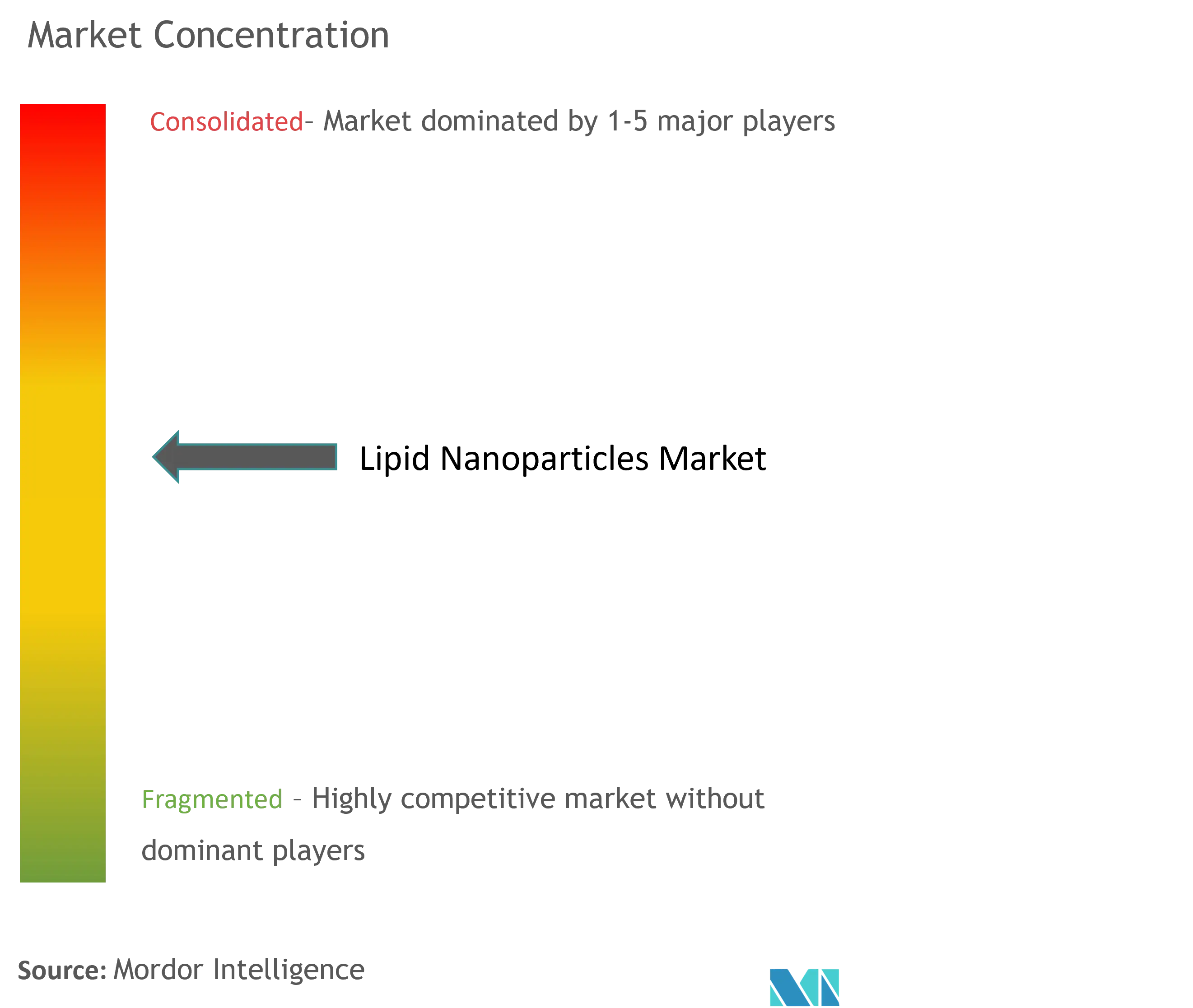
Lipid Nanoparticles Market News
- February 2024: CordenPharma launched Lipid NanoParticle (LNP) Starter Kits for effective mRNA formulation in developing mRNA-based therapeutics such as mRNA vaccines or gene therapies.
- June 2023: Bayer AG partnered with Acuitas Therapeutics Inc., a biotechnology company involved in developing lipid nanoparticle (LNP) delivery systems for molecular therapeutics. Acuitas’ LNP technology will support Bayer’s in vivo gene editing and protein replacement programs to explicitly deliver RNA payloads to the desired target organ, the liver.
Lipid Nanoparticles Market Report - Table of Contents
1. INTRODUCTION
1.1 Study Assumptions and Market Definition
1.2 Scope of the Study
2. RESEARCH METHODOLOGY
3. EXECUTIVE SUMMARY
4. MARKET DYNAMICS
4.1 Market Overview
4.2 Market Drivers
4.2.1 Increasing Prevalence of Chronic Diseases
4.2.2 Rising Focus Towards Personalized Medicine
4.2.3 Growing Investment for Research and Development of Nanotechnology
4.3 Market Restraints
4.3.1 Stringent Regulatory Compliance
4.3.2 Expensive Formulation with Limited Loading Capacity
4.4 Porter's Five Forces Analysis
4.4.1 Threat of New Entrants
4.4.2 Bargaining Power of Buyers/Consumers
4.4.3 Bargaining Power of Suppliers
4.4.4 Threat of Substitute Products
4.4.5 Intensity of Competitive Rivalry
5. MARKET SEGMENTATION (Market Size by Value - USD)
5.1 By Type
5.1.1 Solid Lipid Nanoparticles
5.1.2 Nanostructured Lipid Carriers
5.1.3 Other Types
5.2 By Application
5.2.1 Research
5.2.2 Therapeutics
5.3 By End User
5.3.1 Pharmaceutical and Biotechnology Companies
5.3.2 Contract Development and Manufacturing Organizations
5.3.3 Other End Users
5.4 By Geography
5.4.1 North America
5.4.1.1 United States
5.4.1.2 Canada
5.4.1.3 Mexico
5.4.2 Europe
5.4.2.1 Germany
5.4.2.2 United Kingdom
5.4.2.3 France
5.4.2.4 Italy
5.4.2.5 Spain
5.4.2.6 Rest of Europe
5.4.3 Asia-Pacific
5.4.3.1 China
5.4.3.2 Japan
5.4.3.3 India
5.4.3.4 Australia
5.4.3.5 South Korea
5.4.3.6 Rest of Asia-Pacific
5.4.4 Rest of the World
6. COMPETITIVE LANDSCAPE
6.1 Company Profiles
6.1.1 Merck KGaA
6.1.2 Croda International PLC
6.1.3 Cytiva
6.1.4 BIOVECTRA
6.1.5 Acuitas Therapeutics
6.1.6 CordenPharma
6.1.7 Genevant Sciences Corporation
6.1.8 Arcturus Therapeutics Inc.
6.1.9 Ascendia Pharmaceuticals
6.1.10 CD Bioparticles
- *List Not Exhaustive
7. MARKET OPPORTUNITIES AND FUTURE TRENDS
Lipid Nanoparticles Industry Segmentation
Lipid-based nanoparticles (LNPs) are a highly adaptable class of nanocarriers that have gained widespread usage in medical research and pharmacology. They encapsulate various therapeutic agents for multiple applications, including small molecules, nucleic acids, and monoclonal antibodies. These engineered nanocarriers hold the potential to overcome significant limitations of traditional therapeutic products, such as inadequate efficacy, susceptibility to enzymatic degradation, low bioavailability, and off-target side effects.
The lipid nanoparticles market is segmented into type, application, end user, and geography. By type, the market is segmented into solid lipid nanoparticles, nanostructured lipid carriers, and other types. By application, the market is segmented into research and therapeutics. By end-user, the market is segmented into pharmaceutical and biotechnology companies, contract development and manufacturing organizations, and other end users. By geography, the market is segmented into North America, Europe, Asia-Pacific, and Rest of the World. The report also offers the market size and forecasts for 13 countries across the region. The report offers the value (USD) for the above segments.
| By Type | |
| Solid Lipid Nanoparticles | |
| Nanostructured Lipid Carriers | |
| Other Types |
| By Application | |
| Research | |
| Therapeutics |
| By End User | |
| Pharmaceutical and Biotechnology Companies | |
| Contract Development and Manufacturing Organizations | |
| Other End Users |
| By Geography | ||||||||
| ||||||||
| ||||||||
| ||||||||
| Rest of the World |
Lipid Nanoparticles Market Research FAQs
How big is the Lipid Nanoparticles Market?
The Lipid Nanoparticles Market size is expected to reach USD 0.82 billion in 2024 and grow at a CAGR of 10.54% to reach USD 1.36 billion by 2029.
What is the current Lipid Nanoparticles Market size?
In 2024, the Lipid Nanoparticles Market size is expected to reach USD 0.82 billion.
Who are the key players in Lipid Nanoparticles Market?
Merck KGaA, Arcturus Therapeutics, Inc., Ascendia Pharmaceuticals, Acuitas Therapeutics and Croda International Plc. are the major companies operating in the Lipid Nanoparticles Market.
Which is the fastest growing region in Lipid Nanoparticles Market?
Asia Pacific is estimated to grow at the highest CAGR over the forecast period (2024-2029).
Which region has the biggest share in Lipid Nanoparticles Market?
In 2024, the North America accounts for the largest market share in Lipid Nanoparticles Market.
What years does this Lipid Nanoparticles Market cover, and what was the market size in 2023?
In 2023, the Lipid Nanoparticles Market size was estimated at USD 0.73 billion. The report covers the Lipid Nanoparticles Market historical market size for years: 2019, 2020, 2021, 2022 and 2023. The report also forecasts the Lipid Nanoparticles Market size for years: 2024, 2025, 2026, 2027, 2028 and 2029.
Lipid Nanoparticles Industry Report
Statistics for the 2024 Lipid Nanoparticles market share, size and revenue growth rate, created by Mordor Intelligence™ Industry Reports. Lipid Nanoparticles analysis includes a market forecast outlook for 2024 to 2029 and historical overview. Get a sample of this industry analysis as a free report PDF download.



